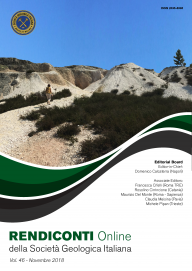
The use of open-source electronic platforms to monitor the efficiency of Borehole Thermal Energy Storage Systems (BTES) in porous materials by means of lab scale modeling
Jessica Chicco (a), Nicolò Giordano (b) & Giuseppe Mandrone (a)
(a) Department of Earth Sciences, University of Torino, Via Valperga Caluso, 35, 10125, Torino, Italy.
(b) Institut National de la Recherche Scientifique, Centre Eau Terre Environnement, 490 Rue de la Couronne, G1K 9A9 Québec (QC), Canada
Corresponding author e-mail: jessica.chicco@unito.it.
Volume: 46/2018
Pages: 155-160
Abstract
In the framework of heating and cooling of buildings, the underground can be used as thermal energy storage to smooth the difference between production and demand. The heat transfer performances vary significantly depending on the type of soil where the plant is set up, but also with the water content and the presence
of groundwater flow. A lab scale modelling aimed at the simulation of thermal energy storage behaviour in porous materials was begun by Giordano et al. (2013) in order to better design the field scale living lab set up in Torino (Giordano et al., 2016). In this work, an implementation of the laboratory device is proposed with a monitoring system made of a low-cost open-source electronic platform based on Arduino®. With respect to the previous version, the heat sources have been eplaced with small scale borehole heat exchangers fed by a heating bath circulator equipped with in/out temperature sensors and flow rate control. Temperature and moisture monitoring within the medium has been improved with new and more accurate sensors. In addition, load sensors have been set up below the box to monitor the moisture migration induced during the heat injection. All the sensors
are read by Arduino® boards and shields thanks to on purpose scripts and the data are monitored by a lab PC.
Keywords
Get Full Text